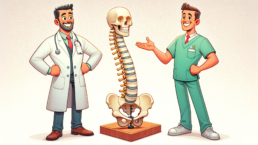Deciding between Osteopathy vs Chiropractor in Denver can be challenging, especially when dealing with musculoskeletal issues. Osteopaths and chiropractors are well-respected healthcare professionals, sharing some similarities in their treatments but differing in their training, ability to prescribe medications, and the conditions they address. Osteopaths treat various conditions using nutritional and medicinal approaches, while a chiropractor in Denver will focus on musculoskeletal issues. This blog post will explore each profession’s differences, benefits, and drawbacks to help you make an informed decision.
Table of Contents
ToggleWhat is Osteopathy?
Osteopathy is an alternative medicine that emphasizes the physical manipulation of the body’s muscle tissue and bones. Osteopaths also adopt a holistic approach to healthcare, considering the entire body rather than just a specific system (like standard medical doctors). They are known for their hands-on techniques, such as stretching, massaging, and spinal manipulation, to promote healing and well-being.
What is Chiropractic?
Our Denver Chiropractors specialize in diagnosing, treating, and preventing mechanical disorders of the musculoskeletal system, focusing on the spine. They use various techniques, including hands-on spinal manipulation, to reduce pain, improve function, and enhance mobility. They also advise on exercise, diet, and lifestyle and offer rehabilitation programs to prevent recurring injuries.
Osteopathy vs Chiropractor Education
Before entering Osteopathic medical school, Hopeful Osteopaths must satisfy undergraduate prerequisites. Following their graduation from Osteopathy school, they move on to a residency consisting of hands-on training, including rotations in various medical specialties. Lastly, before being able to practice, they must pass their state board exam to receive a state license. Chiropractors must also satisfy prerequisites before beginning 4 years of Chiropractic college. Chiropractic education focuses primarily on chiropractic techniques and principles but includes in-depth courses on Diagnosis, Nutrition, Pharmacology, and Biochemistry. After completing their Chiropractic education, Chiropractors must pass a 4 part National board exam and then a state board exam to receive a state license.
Differences Between Osteopathy vs Chiropractor
1. Approach to X-rays
Chiropractors in Denver often utilize X-rays to examine the spine for misalignments or subluxations. By analyzing X-rays from a functional standpoint, chiropractors can distinguish areas of pain from the segments of the spine that are causing that pain. A Denver Chiropractor can also identify pre-disposed areas that may become “problem” areas. In contrast, osteopaths tend to minimize the use of X-rays due to focusing more on areas of stiffness or weakness. The benefits of taking X-rays far outweigh their risks. Digital X-rays (like those taken at Integrative Health and Rehab) expose patients to 90 percent less radiation than conventional X-ray machines. While both are considered relatively safe, digital X-rays are the perfect option for patients who are concerned with the amount of radiation to which they or their loved ones are being exposed.
2. Treatment Philosophy
Both osteopaths and chiropractors use manipulation techniques, but their approaches differ. Our Denver Chiropractor typically focuses on joint and bone misalignments, while osteopaths concentrate on functional limitations, like stiffness, using gentler manipulation methods. Because chiropractors focus on specific areas of spinal misalignment, they attempt to address only those specific spine segments. This is why an integrative Chiropractor performs “adjustments,” and osteopaths perform “manipulations.” Adjustments are meant to create change at a specific spinal segment. At the same time, manipulations are intended to create motion throughout an entire area of the spine. An old chiropractic analogy of the difference between “adjustment” and “manipulation” is “You don’t manipulate a carburetor, you adjust it.”
3. Session Frequency
A Denver Chiropractic sessions are usually shorter, often less than 15 minutes, and may require regular visits for maintenance adjustments. Osteopaths generally have longer sessions, as they more often are dealing not only with “osteopathic” issues but also managing chronic health conditions and medication schedules. At Integrative Health and Rehab, visits can vary from a few minutes to a half hour. That is because of the many treatment options we offer, like acupuncture, dry needling, and shockwave therapy.
4. Practice settings
Osteopaths are more commonly found working in large groups and hospitals than chiropractors. This integration is partly due to osteopaths gradually specializing more in areas like pediatrics, cardiology, and orthopedic surgery. At Integrative Health and Rehabilitation, our staff of Nurse Practitioners, MAs, and integrative Chiropractors can provide Acupuncture, Chiropractic, Dry Needling, Low-Level Laser Therapy, Natural Hormone Replacement Therapy, Shockwave Therapy, and more.
5. Treatment Plans
Integrative Chiropractic offices often encourage patients to return for repeated visits. The goal is to relieve pain and create structural changes leading to long-term improvements. We strive to provide solutions to your problem, not just help you feel better for a moment. Our Denver office will also provide information to help you manage your pain at home with simple stretches and exercises.
“What is Better, Osteopathy vs Chiropractor?”
The better choice between a chiropractor and an osteopath depends on your specific health needs. A chiropractor in Denver may be more suitable if you seek targeted spinal adjustments and quicker sessions. An osteopath could be better if you prefer a holistic approach to managing chronic health concerns like heart disease and diabetes.
Do Osteopaths Adjust the Spine?
Osteopaths are trained to manipulate the spine as part of their holistic treatment approach. However, many no longer practice spinal manipulation. Instead, they focus more on preventative and holistic care of chronic conditions like obesity and heart disease, which have become more prevalent. There are also some large and minor differences between the styles of osteopathic manipulation and chiropractic adjustments.
Osteopathy vs Chiropractor = Manipulation vs Adjustment
The main difference lies in their techniques and focus. Osteopathic manipulation involves various hands-on techniques, focusing on overall bodily function. Chiropractic adjustments focus more on specific joint and spinal manipulations to correct misalignments and improve nerve function.
Decision-making between an osteopath and a chiropractor ultimately comes down to your health needs, preferences, and the specific conditions you want to address. Both professions offer unique approaches to treatment, and understanding these can guide you toward the right choice for your health and well-being.
Still have questions about Osteopath vs. Chiropractor? Looking for a Chiropractor in Denver? Contact us! Still not sure? Read some of our 5-Star Google reviews and see what patients have to say. Our integrative Chiropractor has been helping patients in Arvada, Denver, and Wheat Ridge, Colorado, for over 20 years. Lastly, learn more about the conditions we treat and the benefits of the many types of treatment we provide on our Health Articles page. Ready to start feeling better? Book an appointment online!

Ready for an expert opinion? Get in touch today!
With a legacy of more than 25 years, our team specializes in helping individuals triumph over back pain, neck discomfort, and persistent headaches, all without relying on addictive medications or risky surgical procedures.
Like this article? Spread the word!
Related Posts
December 1, 2023
Treatment for Lower Back Pain
Discover relief from lower back pain with expert insights and treatments. Explore…






